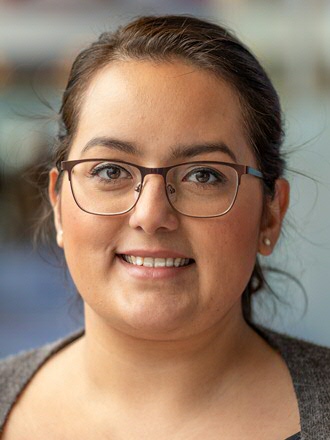Ella Sebamalai | Faces of FEB
The Faculty of Economics and Business is a faculty with a great diversity of people who all have an impact, big or small, on science and society. But who are these people? Within ‘Faces of FEB’ we connect with different students, staff members and researchers of the faculty and give a little peek into their world. This week: Ella Sebamalai, Policy Adviser Internationalisation at FEB.

1. Can you tell us a little bit about yourself?
Introductions are an interesting phenomenon; what is it that I think that could possibly be interesting to read about me? May I combine what diversity means to me with an introduction about me? I was raised as an only child in a multi-cultural family with a father from a Tamil Sri Lankan background and a mother from a Groninger Dutch background. That mix led to an upbringing that was very much about diversity: differences in our skin colour, in the way people perceived us, but also differences in perspective, in religion, language, in generation, in education opportunities, and in culture. More concretely: I am a large brown woman, trained as an internationalist, interculturalist and anthropologist. I was the first in both my maternal and paternal families to pursue an academic degree. It is the combination of these experiences that makes me who I am and that illustrates what diversity means to me.To me, diversity is about visible and invisible elements to a person's identity, that can influence how we are perceived (incl. biases) and how we communicate.
2. It’s diversity month at FEB. What does diversity mean to you?
Diversity has always been present in my life in one way or another. I have learned to reflect on what diversity means to me in different ways: for me personally, and for me as a Diversity, Equity & Inclusion professional. What diversity really means to me is that it is a constant reminder to challenge stereotypes. More importantly, it requires designing support structures for people with different experiences, which can have to do with all kinds of diversity. Even people who do not necessarily regard themselves as “diverse” will have an opinion about diversity that might be different from their environment. I am interested in those dynamics too. By exploring the far ends of all experiences, explicitly or implicitly diverse, I believe we can contribute to a non-exclusive community. That’s hard work and, hopefully for me; a journey for my life-time.
3. How does diversity play a role in your work?
As policy adviser at FEB, I work on topics related to Diversity, Equity, and Inclusion. When I started working here, this was predominantly about internationalisation, but this soon expanded. After all, nationality, language, and culture, are but three elements of diversity. I now work on projects and policies that support an inclusive environment in the broadest sense. Examples are: FEB’s stimulation fund for inclusion, called “Inclusivision”, and a FEB Language policy: “Bilingual with an eye for inclusion”. In my work, I often see diversity being celebrated as enriching factors for a community, a group, or an institution.I believe that diversity and inclusiveness is rather a question of equity. In my view, it is important to design (support) structures that facilitate needs and experiences of specific individuals and groups with regard to diversity. As an alternative to equality (giving everyone exactly equal tools), a system that facilitates specific needs and experiences, contributes to equity.
4. What activities support diversity, equity and inclusion at FEB??
I can think of a few, some of which I work on personally and other activities are worked on throughout the faculty. For instance, the faculty board is currently in the process of positioning a Diversity and Inclusion officer at FEB. I believe that a person with a clear mandate, reporting to the faculty board and HR, contributes to implementation, but we really need the whole community to undertake ownership and responsibility to maintain an inclusive environment. Several training opportunities can facilitate skillbuilding for that. What I work on personally, is for example active bystander training for both students and staff. Other training offered at UG and FEB, to which I contribute: intercultural competence development for individual staff members, inclusive recruitment training for selection committees, and staff training on unconscious bias and the effect on (non) inclusive behaviour. These are all activities that have been developed over the years, and we are in the process of structurally embedding them - within and outside FEB.
5. Could you share your best practices for maintaining a safe and inclusive space (in work and teaching) with us?
- Talk about the difference that difference makes, never stop at just pointing out diversity.
- Assume you have biases. Nobody is unbiased, but when we talk about them more openly we can minimize the effects of bias.
- Consider the objective of equity, look beyond equal tools
- Speak up when you observe inappropriate behaviour. Doing nothing is no option.
- Keep in mind the platinum rule for communication: treat others the way they want to be treated. This is an alternative to the golden rule (treat others the way you want to be treated).
